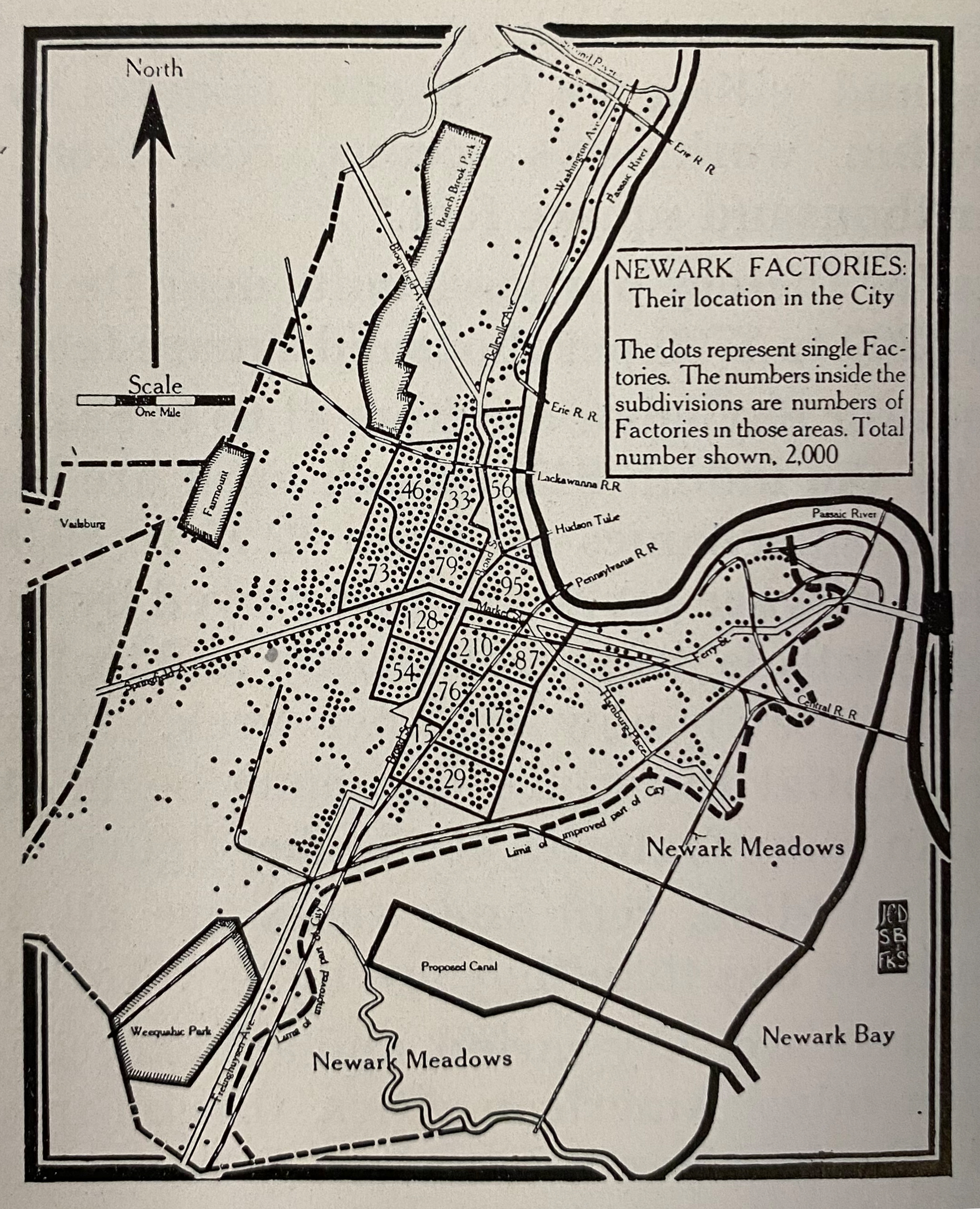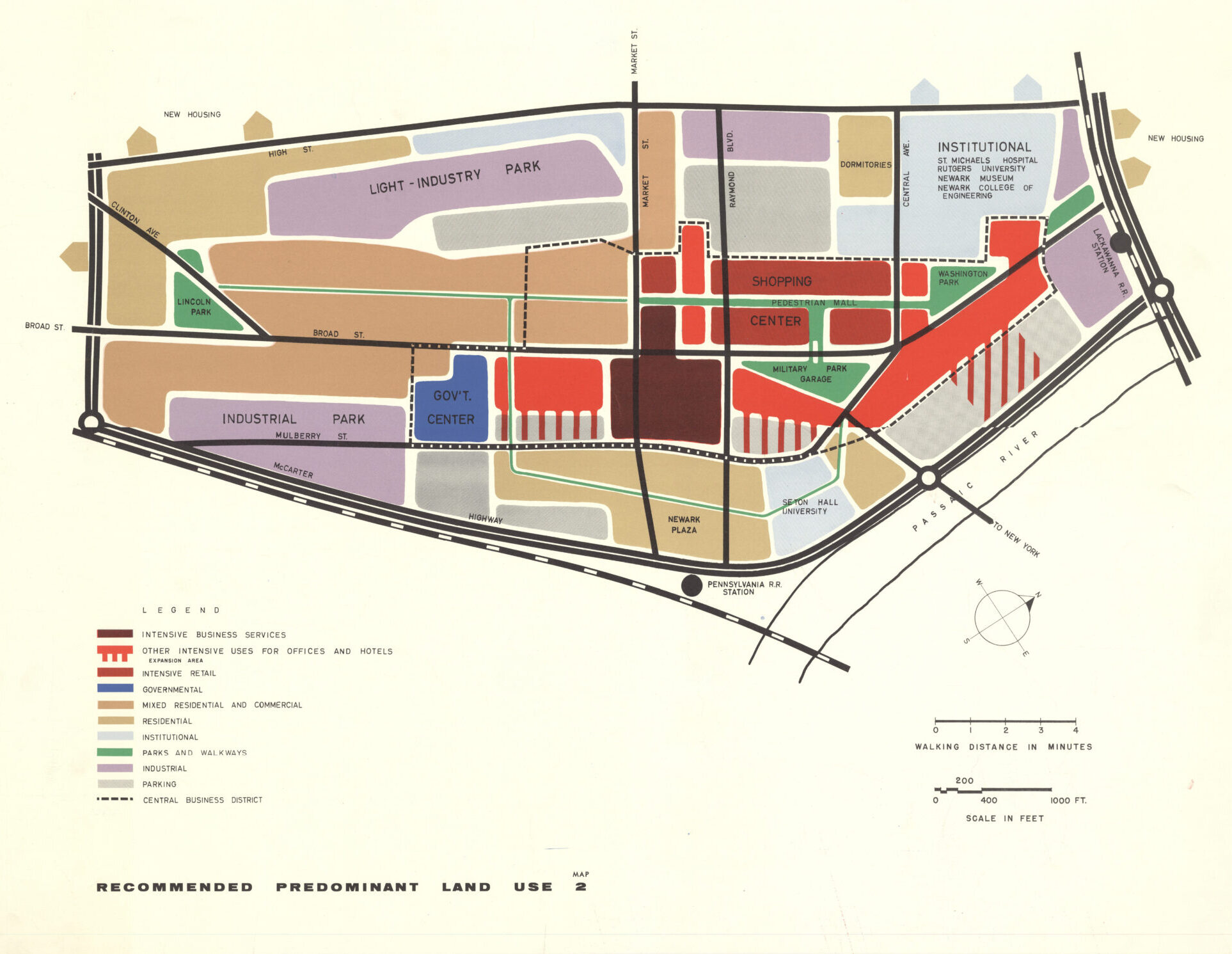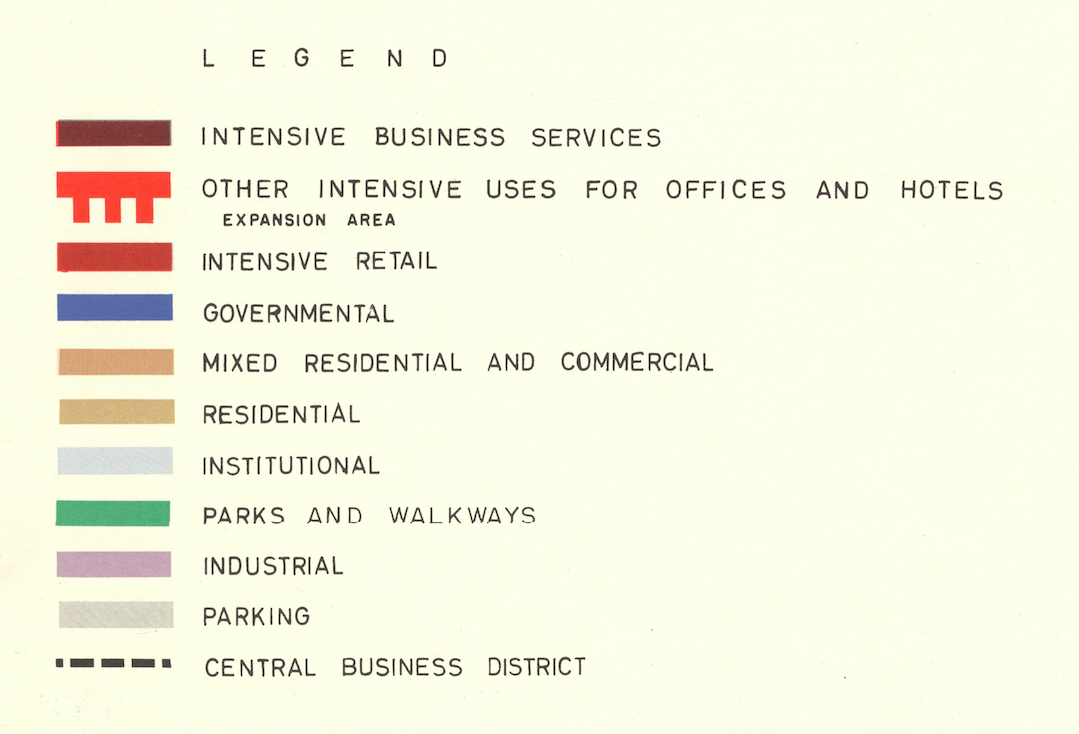
If you see this after your page is loaded completely, leafletJS files are missing.


From Harland Bartholomew’s 1913 master plan. So thorough was de-industrialization in Newark that not one factory dot from this image survives a century later, source.
This is New Jersey’s greatest concentration of polish and finance. It’s worn and blighted. But we have the spirit and vigor to grow and build anew as here in the new campuses of Rutgers University and the Newark College of Engineering. In time they will accommodate 25,000 students making Newark a college town. Newark has undertaken more urban renewal per capita than any other of the nation’s 30 major cities. In our time, one-fifth of our city will have been rebuilt with projects like these.
– 1966 newsreel on urban renewal efforts
During the past century, Newark lost the economic foundation it once had of factories, heavy industries, and easy-to-find employment on the factory floor. Detroit’s economy was shaped by the three largest employers – General Motors, Chrysler, and Ford – along with hundreds of other smaller industries that supplied parts and materials to the auto assembly lines. Newark’s industrial base, in contrast to an auto city like Detroit, a camera city like Rochester, and a fabric city like Lowell, was always more varied and more diverse in its number and variety of small manufacturers. However, no diversity of manufacturing enterprises excused any northeastern city from the aftershocks of industrial decline.
Economic growth follows a similar pattern on the local, national, and international scales. Manufacturing mostly happens in developing countries, where labor is cheap and raw materials are abundant. Meanwhile, more developed countries engage in new industries in the service sector, such as insurance, banking, and white-collar work in corporate America. This shift from industrial to service sector effected Newark and just about every American city of any size. There are winners like San Francisco now home to high-tech industries. And there are losers like Detroit that has not found (and will likely never find) a new industry that will give the city as much prosperity and wealth as the auto industry. Manufacturing jobs were the lever of social mobility for the working classes to migrate up into the middle classes. America’s shrinking manufacturing jobs mirror a shrinking middle class.
After WWII, there was a brief moment when it seemed Newark’s manufacturing base would survive. It was a moment when it seemed distant suburbs could grow and surround Newark without siphoning off people, energy, and employment from Newark. And yet, by the late 1950s, city leaders saw the city losing both people and its industrial base. Decades of technological progress had made factories larger, transportation cheaper, and mechanization easier. Factories needed fewer laborers to make more products, and hence there was less reason for factories to remain in cities like Newark. Taxes were higher, transportation was more expensive, and there was no need to remain within walking distance of the neighborhoods and immigrant enclaves where cheap immigrant laborers once lived.
In the 1910s, over 50% of Newark’s jobs were found in manufacturing and industries that served manufacturing. By 1912, there were 2,000 factories employing 76,000, producing goods worth $220 million. By the 1960s, this had fallen to less than 30%. And today, it is less than 5%. In the 1950s, Newark’s city leaders were worried with the trends they saw: declining industrial employment, rising unemployment, aging infrastructure and city services, declining tax revenue, and a population flight of wealth and middle-class people to the suburbs. Those left behind in Newark were the unemployed, the urban poor, Blacks, and a small but soon-to-grow number of immigrants from the Caribbean and Latin America. (Latin Americans and Mexicans only started arriving in northeastern cities after 1965 changes to immigration law.) Newark needed industrial employment, but it did not have the land in the centuries-old urban core for growing factories. Newark needed to attract and grow service sector jobs in insurance, banking, and higher education, but it did not have the financial resources to retain these employers downtown.
The truly dynamic American cities are those that are coming to grips with the problem of outmoded structures. Increasingly we are seeing large-scale demolition as the first step in building modern cities. the need of the hour is to acquire plottage by merging narrow lots for a new start. Getting needed space in our cities for modern structures is the only way to meet the competitive force of growing suburban strength.
– 1950s film from the U.S. Chamber of Commerce
In response, not just in Newark but nationwide, a program of urban renewal was introduced. University structures in Brutalist concrete replaced the homes of thousands of people. Newark’s new employment base would become the university. Industrial production would become knowledge production. In some ways, this dream became a reality. Newark is now the state’s largest college town with the campuses of Rutgers, Rutgers Medical School, Seton Hall, Essex County College, and the New Jersey Institute of Technology. Together these universities host 25,000 mostly middle-class students on land where 25,000 mostly-Black and working-class residents once lived. A more desirable social class has replaced a less desirable one. In other ways, the vision of urban renewal failed. Plans for the college campus replaced walkable, historical, and visually exciting streetscapes with hundreds of acres of surface parking and college campuses that face away from the street and city. All of Newark’s universities are commuter schools, where the majority of students and faculty live outside Newark. Newark has 200,000 jobs. Nearly half these jobs offer middle-class salaries upwards of $50,000. And yet, the majority of people who work in these schools live outside Newark. Wealth generated in Newark does not stay in Newark.
Dr. Berg’s photos show what the campuses of Newark’s universities looked like before clearance for urban renewal. These were mostly Black and multiracially integrated neighborhoods wiped clean from the map. City leaders reasoned that public housing, residential areas, and homes should not be near downtown. Mid-century planners used land use zoning to separate commercial and residential areas, to produce the mono-culture neighborhoods we see today that are all residential (and inactive on workdays) or all commercial (and inactive outside working hours). The White Downtown should be a commercial and commuter area. Downtown should be linked to the all-White suburbs by highways, and it should be separated from the nearby “Negro” neighborhoods by a belt of public housing and university campuses. Indeed, Downtown Newark is now surrounded to its west by the campuses of Rutgers and the New Jersey Institute of Technology. Blight and Black were to be buffered from the wealth of Downtown by the university. Educational institutions were transformed into tools of slum clearance and the city’s economic re-orientation.


Notice the brown arrows around perimeter of map pointing toward areas for constructing “new housing.” This table of urban renewal projects indicates that areas where housing was demolished and not replaced were concentrated in downtown. Areas where more housing was added than demolished were located closer to the city edge. This illustrates the drive toward population decentralization. (Source)
As you view these photos, consider: What can the university do to repair the damage it did in the 1960s to thousands of Blacks in dozens of neighborhoods? How can the redesign of its campuses better integrate into the urban streetscape and begin to rebuild the quality of urban form that was lost to urban renewal? If the built environment is to be a tool for social equity, then the university must be the place to start. Efforts over the past decade from Rutgers at its Living Learning Center and NJIT at its new dorms on Warren Street continue to transform these schools into anchor institutions and 24/7 campuses active in the city and in neighborhood life. Rutgers has come a long way in its urban polices, in its diversity of faculty and students, in its campus design, and in its urban focus since its 1960s origins as an agent of slum clearance.